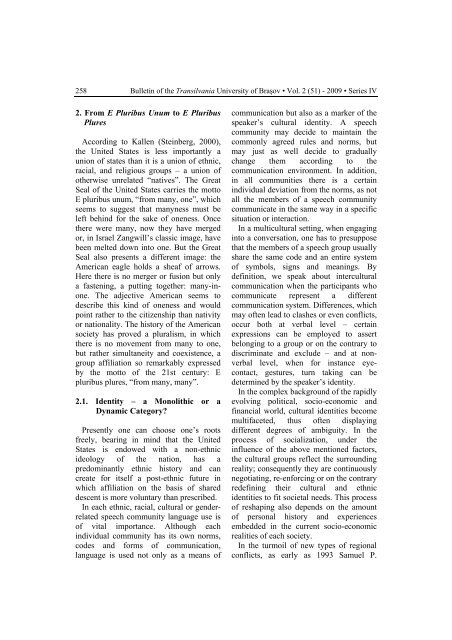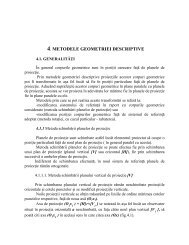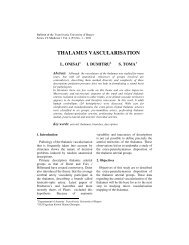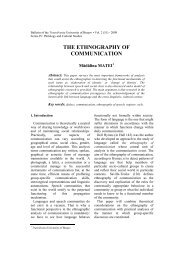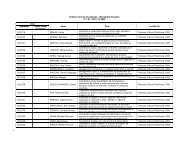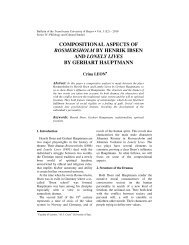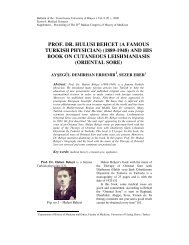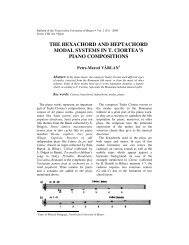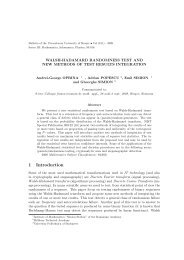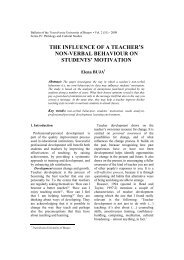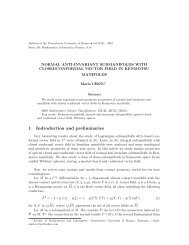Hortobágyi, I.: The Role of Identity in Intercultural Communication
Hortobágyi, I.: The Role of Identity in Intercultural Communication
Hortobágyi, I.: The Role of Identity in Intercultural Communication
Create successful ePaper yourself
Turn your PDF publications into a flip-book with our unique Google optimized e-Paper software.
258<br />
Bullet<strong>in</strong> <strong>of</strong> the Transilvania University <strong>of</strong> Braşov • Vol. 2 (51) - 2009 • Series IV<br />
2. From E Pluribus Unum to E Pluribus<br />
Plures<br />
Accord<strong>in</strong>g to Kallen (Ste<strong>in</strong>berg, 2000),<br />
the United States is less importantly a<br />
union <strong>of</strong> states than it is a union <strong>of</strong> ethnic,<br />
racial, and religious groups – a union <strong>of</strong><br />
otherwise unrelated “natives”. <strong>The</strong> Great<br />
Seal <strong>of</strong> the United States carries the motto<br />
E pluribus unum, “from many, one”, which<br />
seems to suggest that manyness must be<br />
left beh<strong>in</strong>d for the sake <strong>of</strong> oneness. Once<br />
there were many, now they have merged<br />
or, <strong>in</strong> Israel Zangwill’s classic image, have<br />
been melted down <strong>in</strong>to one. But the Great<br />
Seal also presents a different image: the<br />
American eagle holds a sheaf <strong>of</strong> arrows.<br />
Here there is no merger or fusion but only<br />
a fasten<strong>in</strong>g, a putt<strong>in</strong>g together: many-<strong>in</strong>one.<br />
<strong>The</strong> adjective American seems to<br />
describe this k<strong>in</strong>d <strong>of</strong> oneness and would<br />
po<strong>in</strong>t rather to the citizenship than nativity<br />
or nationality. <strong>The</strong> history <strong>of</strong> the American<br />
society has proved a pluralism, <strong>in</strong> which<br />
there is no movement from many to one,<br />
but rather simultaneity and coexistence, a<br />
group affiliation so remarkably expressed<br />
by the motto <strong>of</strong> the 21st century: E<br />
pluribus plures, “from many, many”.<br />
2.1. <strong>Identity</strong> – a Monolithic or a<br />
Dynamic Category?<br />
Presently one can choose one’s roots<br />
freely, bear<strong>in</strong>g <strong>in</strong> m<strong>in</strong>d that the United<br />
States is endowed with a non-ethnic<br />
ideology <strong>of</strong> the nation, has a<br />
predom<strong>in</strong>antly ethnic history and can<br />
create for itself a post-ethnic future <strong>in</strong><br />
which affiliation on the basis <strong>of</strong> shared<br />
descent is more voluntary than prescribed.<br />
In each ethnic, racial, cultural or genderrelated<br />
speech community language use is<br />
<strong>of</strong> vital importance. Although each<br />
<strong>in</strong>dividual community has its own norms,<br />
codes and forms <strong>of</strong> communication,<br />
language is used not only as a means <strong>of</strong><br />
communication but also as a marker <strong>of</strong> the<br />
speaker’s cultural identity. A speech<br />
community may decide to ma<strong>in</strong>ta<strong>in</strong> the<br />
commonly agreed rules and norms, but<br />
may just as well decide to gradually<br />
change them accord<strong>in</strong>g to the<br />
communication environment. In addition,<br />
<strong>in</strong> all communities there is a certa<strong>in</strong><br />
<strong>in</strong>dividual deviation from the norms, as not<br />
all the members <strong>of</strong> a speech community<br />
communicate <strong>in</strong> the same way <strong>in</strong> a specific<br />
situation or <strong>in</strong>teraction.<br />
In a multicultural sett<strong>in</strong>g, when engag<strong>in</strong>g<br />
<strong>in</strong>to a conversation, one has to presuppose<br />
that the members <strong>of</strong> a speech group usually<br />
share the same code and an entire system<br />
<strong>of</strong> symbols, signs and mean<strong>in</strong>gs. By<br />
def<strong>in</strong>ition, we speak about <strong>in</strong>tercultural<br />
communication when the participants who<br />
communicate represent a different<br />
communication system. Differences, which<br />
may <strong>of</strong>ten lead to clashes or even conflicts,<br />
occur both at verbal level – certa<strong>in</strong><br />
expressions can be employed to assert<br />
belong<strong>in</strong>g to a group or on the contrary to<br />
discrim<strong>in</strong>ate and exclude – and at nonverbal<br />
level, when for <strong>in</strong>stance eyecontact,<br />
gestures, turn tak<strong>in</strong>g can be<br />
determ<strong>in</strong>ed by the speaker’s identity.<br />
In the complex background <strong>of</strong> the rapidly<br />
evolv<strong>in</strong>g political, socio-economic and<br />
f<strong>in</strong>ancial world, cultural identities become<br />
multifaceted, thus <strong>of</strong>ten display<strong>in</strong>g<br />
different degrees <strong>of</strong> ambiguity. In the<br />
process <strong>of</strong> socialization, under the<br />
<strong>in</strong>fluence <strong>of</strong> the above mentioned factors,<br />
the cultural groups reflect the surround<strong>in</strong>g<br />
reality; consequently they are cont<strong>in</strong>uously<br />
negotiat<strong>in</strong>g, re-enforc<strong>in</strong>g or on the contrary<br />
redef<strong>in</strong><strong>in</strong>g their cultural and ethnic<br />
identities to fit societal needs. This process<br />
<strong>of</strong> reshap<strong>in</strong>g also depends on the amount<br />
<strong>of</strong> personal history and experiences<br />
embedded <strong>in</strong> the current socio-economic<br />
realities <strong>of</strong> each society.<br />
In the turmoil <strong>of</strong> new types <strong>of</strong> regional<br />
conflicts, as early as 1993 Samuel P.


